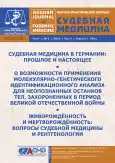О возможности применения молекулярно-генетического идентификационного анализа для неопознанных останков тел, захороненных в период великой отечественной войны
- Авторы: Земскова Е.Ю.1, Иванов П.Л.1
-
Учреждения:
- Российский центр судебно-медицинской экспертизы
- Выпуск: Том 7, № 2 (2021)
- Страницы: 77-82
- Раздел: Оригинальные исследования
- URL: https://journals.rcsi.science/2411-8729/article/view/122398
- DOI: https://doi.org/10.17816/fm379
- ID: 122398
Цитировать
Полный текст
Аннотация
Актуальность. Молекулярно-генетические исследования применяются в судебно-экспертной работе для идентификации останков жертв природных и техногенных катастроф, чрезвычайных ситуаций, а также военных конфликтов. Цель исследования — изучить и обобщить материалы судебно-медицинских молекулярно-генетических экспертиз, проведенных в ФГБУ РЦСМЭ Минздрава России в рамках идентификации жертв Великой Отечественной войны (ВОВ) на территории Российской Федерации, с целью оценить перспективы и возможности применения молекулярно-генетического идентификационного анализа для неопознанных останков тел, захороненных в период 1939–1945 гг. Материал и методы. Изучено 30 экспертных заключений с 2006 по 2021 г. От 171 скелетированного тела из эксгумированных захоронений общее число исследованных объектов составило 421 (костные останки: фрагменты костей и зубы, от 1 до 5 объектов от одного тела). Результаты. Установлены генотипы останков 167 человек. Доказательное решение молекулярно-генетической идентификации составляет 98% от общего числа случаев (n=171), из них положительная идентификация — для 10 человек; отрицательная идентификация — для 157. Непригодными для исследования оказались останки 4 скелетированных тел (2% от общего числа). В большинстве случаев применялись схемы непрямой идентификации — сравнительное исследование идентифицируемых с заявленными родственниками путем биостатистического анализа, основанного на вероятностно-статистическом анализе характера совпадения аллельных состояний полиморфных локусов аутосомной ДНК, а также путем прямого сравнительного анализа полиморфизма ДНК Y-хромосомы и митохондриальной ДНК. Заключение. Молекулярно-генетические исследования являются высокоэффективным инструментом для идентификации останков жертв природных и техногенных катастроф, военных конфликтов и иных чрезвычайных ситуаций. Результаты многочисленных успешно выполненных судебно-медицинских молекулярно-генетических экспертных исследований, проведенных в ФГБУ РЦСМЭ Минздрава России в рамках идентификации жертв ВОВ, наглядно демонстрируют эти возможности. В то же время надо подчеркнуть, что такой тип экспертизы относится к категории особо сложных молекулярно-генетических исследований и в зависимости от обстоятельств требует использования расширенных панелей аналитических тест-систем, а также применения особых методических приемов и аппаратно-программных средств.
Полный текст
Открыть статью на сайте журналаОб авторах
Елена Юрьевна Земскова
Российский центр судебно-медицинской экспертизы
Автор, ответственный за переписку.
Email: zemskova@rc-sme.ru
ORCID iD: 0000-0002-2669-0877
к.м.н.
Россия, 125284, Москва, ул. Поликарпова, д. 12/13Павел Леонидович Иванов
Российский центр судебно-медицинской экспертизы
Email: dna@rc-sme.ru
ORCID iD: 0000-0002-4753-3125
д.б.н., профессор
Россия, 125284, Москва, ул. Поликарпова, д. 12/13Список литературы
- Gill P., Ivanov P., Kimpton C., et al. Identification of the remains of the Romanov family by DNA analysis // Nature Genetics. 1994. Vol. 6, N 2. P. 130–135. doi: 10.1038/ng0294-130
- Земскова Е.Ю., Тимошенко Т.В., Иванов П.Л. Молекулярно-генетическая экспертиза при расследовании обстоятельств гибели людей, летевших на авиалайнере AIRBUS 321 EI-ETJ (Шарм-Эль-Шейх–Санкт-Петербург) // Судебная медицина. 2016. Т. 2, № 2. C. 152–154.
- Земскова Е.Ю., Тимошенко Т.В., Иванов П.Л. Молекулярно-генетическая идентификация останков жертв авиакатастрофы Airbus 321 «Метроджет» над Синайским полуостровом / Труды Всероссийской научно-практической конференции «Организация судебно-медицинской службы России на современном этапе: задачи, пути решения, результаты», Воронеж, 20–22 апреля 2016 г. / под общей ред. А.В. Ковалева. Воронеж, 2016. С. 284–289.
- Palo J.U., Hedman M., Soderholm N., Sajantila A. Repatriation and identification of Finnish World War II soldiers // Croatian Medical Journal. 2007. N 48. Р. 528–535.
- Dzijan S., Primorac D., Marcikic M., et al. High estimated likelihood ratio might be insufficient in a DNA-lead process of identification of war victims // Croatica Chemica Acta. 2005. N 78. Р. 393–396.
- Корниенко И.В., Якушев В.В., Фролова С.А. и др. Некоторые результаты использования молекулярно-генетических маркеров хромосомной ДНК для идентификации неопознанных останков военнослужащих, погибших в ходе боевых действий на Северном Кавказе // Судебно-медицинская экспертиза. 2003. T. 46, № 5. С. 36–41.
Дополнительные файлы








